Learn about vigorexia , what it is, its consequences, how to treat it, how to prevent it and why this condition happens. We live in a period where body image has gained greater weight compared to previous times. Neither adolescents nor adults are exempt from suffering from image-related disorders. The imposed beauty standards are sometimes too difficult to achieve. Therefore, it is necessary to know the pathologies well. We must stay up to date to protect our young people and ourselves.
Definition of vigorexia
What is vigorexia? Is it an ED? Yes, it is a disorder related to self-perception and distortion of body image that can lead to alterations in eating behavior. It is also known as muscle dysmorphia or reverse anorexia . Vigorexia is an eating disorder that mainly affects men, although it can also affect women. This problem falls into the group of eating disorders, such as bulimia or anorexia.
According to official sources, vigorexia is a pathological obsession with developing muscles. It occurs when a person never looks muscular enough; Therefore, they believe that they should train and eat more and more to accumulate more muscle mass. Even when many individuals present an objectively muscular body to the world's eyes, they still see themselves as thin or small in front of the mirror. The obsession with improving their physical condition causes these people to neglect other important aspects of their lives such as social relationships, having fun or eating a more balanced diet. Vigorexia is also related to the use of anabolic steroids to increase muscle mass.
The WHO definition of vigorexia is becoming irrational and extreme obsessed with one's physique. This even leads to complications with feeding. The meaning is also included in the DSM 5 , the Book of the American Psychiatric Association, which encompasses the pathology in body dysmorphic disorders. Other official places where you can find information are Scielo and Mayo Clinic.

What are the characteristics of vigorexia?
There are some vigorexia tests that are used by psychologists to evaluate whether a person suffers from this disorder. We will talk about them later, although we can anticipate some characteristics associated with the problem. Normally, vigorexic people show several symptoms:
- They look at their own body excessively, for example, in front of the mirror.
- They give excessive priority to their physical training programs and diets. For example, these people may become obsessed with the number of calories or macronutrients they consume or be unable to skip a single workout (they feel bad if they miss a day at the gym).
- They never seem to be happy with their physical appearance; They never look like they have enough muscle or the desired size.
- Vigorexics continually compare their bodies to those of other muscular people (often hard-to-get bodies like those of certain actors, bodybuilders and other elite athletes).
- They consume an excessive amount of protein and meet rigorous daily goals for total protein intake.
- Obsession with exercise and nutrition plans can affect your relationships with friends, family, and even your studies and work. Exercise or weight training can become the center of life for a person with vigorexia.
- Often, they do not want to expose their body in public because they feel that they are not muscular enough.
- They follow unrealistic training and nutrition plans to lead a normal and happy life. This causes them great stress.
- They always think about how to be more muscular, even if they already objectively have a pretty strong body compared to most people.
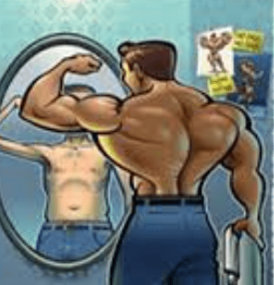
Watch out! Keep in mind that weight training or bodybuilding are sports that require a healthy lifestyle, mental focus and consistency. This means that anyone who trains consistently, whether for recreational or competitive purposes, cannot be labeled as a muscle dysmorphia patient. It is not bad in itself to try to improve your activity or set goals. The problem comes when certain habits interfere with the person's life, work, social relationships or self-esteem. Then, the consequences of vigorexia appear and it must be treated.
Are you interested?:
History of vigorexia

It is not known exactly when people began to suffer from this mental pathology, but it possibly has to do with the change in male beauty standards that emerged in the 80s. In fact, sports such as bodybuilding were already practiced since 1950. What's more, In Ancient Greece and Rome, the cult of the body was already a reality practiced by philosophers, nobles and athletes.
But the truth is that muscles began to have a big impact on the minds of modern men because of movies and steroids. To play any hero, be it a gladiator, Superman, a soldier or a robot from the future, actors become increasingly muscular. We have seen this phenomenon occurring since the 1980s, when characters like Arnold Schwarzenegger, Sylvester Stallone or Jean Claude Van Damme "exported" their muscles to the world through cinema. Millions of men were fascinated by their incredible physiques and, without realizing it, a canon was established.
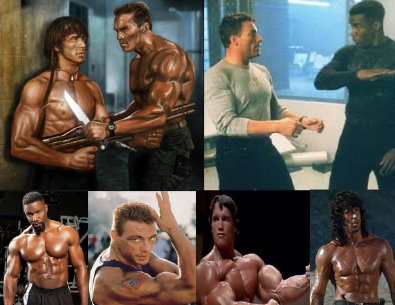
And it was not only in Hollywood that muscular and supernatural bodies stood out. If we look at toys, action figures increasingly have physiques more similar to those of a bodybuilder. The same applies to magazine models and athletes such as rugby players.
The prototype that has been defined as the ideal male body is a very muscular man, broad in the shoulders and with a narrow waist, or failing that, someone with very marked muscles due to low levels of fat.

When actor Mark Hamill saw the next version of the Luke Skywalker action figure (based on him), he exclaimed, "Oh my God! They gave me steroids!"
What is behind all this? Since the 1950s and 1960s, steroids were a common aid in bodybuilding; and since the 80s, they were a reality in the cinema. They are substances that take human muscles to supernatural limits of growth (at the cost of health). The physiques achieved with anabolics create false expectations in people (and frustrations).
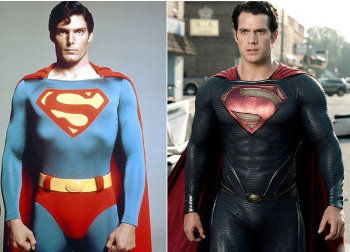
A clear increase in muscularity is shown between Christopher Reeve's Superman (1978) and Henry Cavill (2013). The same goes for the superhero Batman:
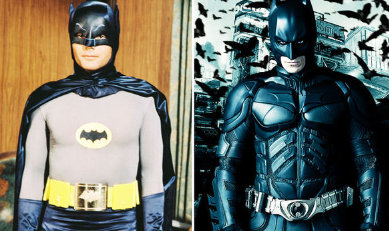
Before, the protagonists of movies had normal bodies; athletic, yes, but normal. Today, it is impossible for an actor to do a bare-chested scene without showing off sculpted muscles and fully visible abs. And it's not just steroids that come into play! The shirtless scenes are filmed under very specific conditions: the actors sometimes undergo strict dehydration processes; In addition, drawing on the muscles is used for shading, optimal lighting conditions, muscle pumping before shooting the scenes and the best angles and poses. It's all an illusion, but the viewers don't know it!
After being bombarded with the incredible bodies of the superheroes that we have admired since we were children, vigorexia is born .
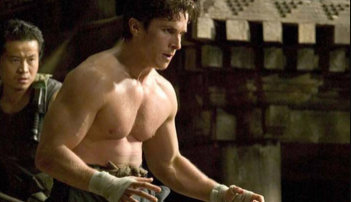
The body that Christian Bale had to obtain to play Batman.
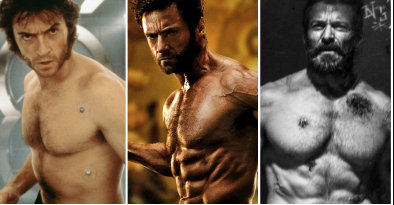
Hugh Jackman showed off a naturally athletic physique in the first X-Men movie, but the production director thought he looked too thin compared to the Wolverine from the comics. Therefore, for the subsequent X-Men films, Jackman underwent a muscle transformation for which he probably used steroids.

Wolverine character in the X-Men comics.
Are you interested?:
Causes
The concept of vigorexia and its causes are relatively recent phenomena. This mental illness entails a complex psychological and biological history. However, the number of people suffering from it is increasing at an alarming rate. This is due to the social and cultural idealization of certain male and female bodies, which can cause an inferiority complex in some people. More and more people suffer from eating disorders such as muscle dysmorphia or vigorexia. It most commonly affects men between 25 and 35 years of age.
Social pressures and the media's representation of what the "ideal" male body image should be are not the only factors that determine the development of vigorexia. Some studies indicate that muscle dysmorphia is also an obsessive-compulsive disorder. Other research has shown that it could be a response to physical or sexual abuse. It has also been shown that there is a correlation with childhood bullying victimization. More research is needed before we can fully understand the underlying causes of this problem.

Action Man toy in 1966.

More modern Action Man figure with greater muscle development.
Diagnosis and treatment
For the diagnosis in cases of vigorexia, we try to detect the following behaviors. Muscle dysmorphia will exist when the person continually shows two or more of them.
- Loss of social relationships or work as a result of following physical training programs.
- Put exercise and nutrition above everything in life.
- Being afraid or ashamed of showing your body.
- Train at all costs, even when you have a physical injury. Using steroids.
A vigorexia test is usually used in psychology to determine if a person suffers from the disorder. The score obtained in the questionnaire questions will be used to assess whether or not there is a body image disorder.
The treatment for cases of vigorexia is normally psychotherapy . Self-perception and image disorders can be difficult to detect. Therefore, the family environment must be very attentive to any symptom that raises suspicion. As with any addictive or compulsive problem, the person who suffers from the disorder usually does not recognize for themselves that they have a problem. The support of the family and social environment is decisive for the person to seek help. Treatments for vigorexia disorder depend on the severity of the condition.
- If the condition is mild , perhaps cognitive behavioral therapy (CBT) is sufficient. This will be conducted by the therapist or psychologist.
- In severe cases , antidepressants will be prescribed , which may also be accompanied by cognitive-behavioral therapy.
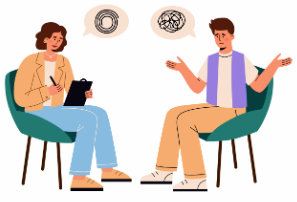
The first action in seeking help should be to consult your GP, who will be able to refer you to the appropriate professional. Many vigorexic people do not know that they are suffering from muscle dysmorphia. If you are a family member, friend or partner of a person who could be suffering from this disease, you have to encourage them to seek help. This information about vigorexia can serve as a guide to identify an affected person.
The person must be convinced to visit a doctor, because without a professional the problem cannot be cured. Special attention must be paid to adolescents , as they are at an age where they are susceptible to worrying excessively about body image. Self-perception disorders are very
Although there is no specific pharmacological treatment for vigorexia, psychological therapy will be the first effective tool to combat it. Some antidepressants have been shown to be effective when muscle dysmorphia results from obsessive-compulsive disorder. A psychology professional will be able to identify harmful thinking patterns and the behaviors that are behind the problem.
Read as much information as possible about vigorexia and help your friend or family member by showing them the treatment options they could use. Therapy can help change negative thought patterns.
Vigorexia test
There are some diagnostic tests for vigorexia used by professionals. Some are question questionnaires and others are interactive (virtual or with images). In USA and the UK, for example, the Muscle Satisfaction Scale is used , one of the methods that has yielded the most successful results for diagnosis.
Muscle Satisfaction Scale
It is a test created in 2002 with 19 questions to assess the symptoms of vigorexia. Various responses of 1 to 5 points can be given such as "I totally agree" or "I totally disagree." The questions are related to five categories:
- Dependence on weight training or bodybuilding.
- Compulsive muscle checking behaviors.
- Use of doping substances.
- Injuries.
- Muscle satisfaction level.
Somatomorphic Matrix
It is a computer program created by Amanda Gruber in 1998. In this case, the person to be diagnosed has to identify photographs of male bodies . The bodies shown can be very obese or very muscular. Each image has an associated muscle mass index ( FFMI ). In the test, there are up to 100 photographs classified according to four groups:
- Bodybuilder body (lots of muscle and little fat).
- Sumo body (a lot of muscle and a lot of fat).
- Potato body (little muscle and a lot of fat).
- Pencil body (little muscle and little fat).
Bodybuilder:
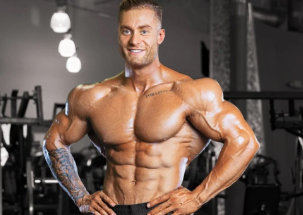
Sumo:
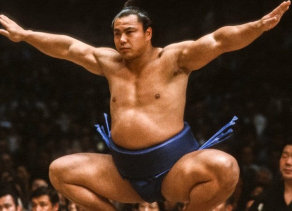
Potato:
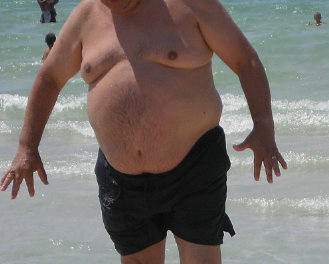
Pencil:

The first thing to carry out the test is to take the height (m) and weight (kg) measurement of the person. The person's body fat percentage is then calculated using the skinfold measurement system with a caliper. Up to 6 skin folds will be measured. Images of people with different levels of muscle mass according to the FFMI are shown. This is known as the muscle mass index.
- An FFMI of 18 kg/ m² is that of a person with little muscle.
- A FFMI of 22 kg/ m² is a muscular person.
- An FFMI of 25 to 26 kg/ m² is a very muscular person and suspected of having used anabolic steroids, since it is not normal to reach those levels naturally.
It also changes the body fat percentage of the people in each photo. From 4% (typical of a bodybuilder in competition status) to 40% (a significantly overweight person).
Given the images, which have different percentages of associated muscle and fat, the participant must answer some questions. For example:
- Which image best represents your body?
- What image shows the body you would like to have?
- What image represents the body of a person your age?
- Which image shows the body most desired by the opposite sex?
The answers given by the person to the first three questions (real physique, perceived physique and ideal) will be contrasted with the person's FFMI and the objective FFMI of each photograph. Depending on the deviation that exists between the person's perception and the reality of each photograph, it can be determined whether or not the participant has a muscle dysmorphia problem (which could be none, mild or severe).
This virtual test can also be carried out by family members or the person's partner. In this case, the participant must put himself in the place of the man with the problem and respond as he thinks he would respond.
Are you interested?:
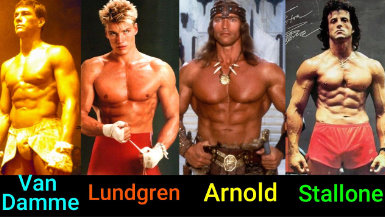
Actors from the era where muscles conquered cinema. Jean-Claude Van Damme, Dolph Lundgren, Arnold Schwarzenegger and Sylvester Stallone.

Incredible Hulk toy.
Adonis Complex Test
In Greek mythology, Adonis was a half-god and half-man, and the greatest exponent of male beauty. For this reason, vigorexia is also called the "Adonis complex" . It refers to a man's obsession with obtaining the perfect body.
The next instrument for evaluating muscle dysmorphia is the Adonis complex questionnaire or test , which was created in 2000. The questionnaire contains 13 multiple choice questions with three possible answers ("a", "b" or "c"). . The questions are about the degree of dissatisfaction that a man has regarding his physical appearance. Answer "a" is worth 0 points, answer "b" is worth 1 point, and answer "c" is worth 3 points.
Between 0 and 9 points, concern about the physique does not affect the person's daily life; from 10 to 19 points, there is a condition of moderate vigorexia (which will be more worrying if it approaches 19 points); between 20 and 29 points, vigorexia negatively affects life and a psychologist/specialist should be consulted; and between 30 and 39 points, the problem is really serious and you should immediately contact an ED specialist to begin treatment.

Statue of Adonis
Example of muscle dysmorphia test
We show you the 13 questions of the Adonis complex test . In the previous section, you have explained the value assigned to each answer and the result of the test according to the total score obtained. You have to answer honestly.
1. How much time do you spend each day worrying about your appearance (not just thinking about it, but worrying about it)?
a. Less than 30 minutes.
b. Between 30 and 60 minutes.
c. More than 30 minutes.
2. How often do you feel bad about something related to your appearance (are you worried, depressed...)?
a. Never or rarely.
b. Sometimes.
c. Frequently.
3. How often do you avoid letting your body or certain parts of it be seen by others?
For example, you avoid locker rooms, swimming pools, or situations where you have to take off your clothes. Also if you wear clothes that alter or hide your appearance (such as baggy clothes to hide the body).
a. I never or rarely do it.
b. Sometimes.
c. Frequently.
4. How much time do you spend per day on grooming activities to improve your appearance?
a. Less than 30 minutes.
b. From 30 to 60 minutes.
c. More than 60 minutes.
5. How much time do you spend a day doing physical activities to improve your appearance (lifting weights, running outdoors or on a machine...)?
Only exercise whose main objective is to improve physical appearance.
a. Less than 60 minutes.
b. Between 60 and 120 minutes.
c. More than 120 minutes.
6. How often do you eat special diets (for example, high-protein or low-fat foods) or take nutritional supplements to improve your physique?
a. Never or rarely.
b. Sometimes.
c. Frequently.
7. How much of your money do you spend on issues related to improving your physical appearance (such as special foods for diet, supplementation, cosmetics, sports equipment, gym fees, etc.)?
a. Insignificant amounts.
b. A significant amount, but never to the point that it causes me financial problems.
c. A sufficient amount to even create financial problems for me.
8. How often do activities related to physical appearance affect your social relationships?
We are referring to the time dedicated to training, special eating practices or any other activity aimed at appearance that ends up affecting your relationships with other people.
a. Never or rarely.
b. Sometimes.
c. Frequently.
9. How often has your sex life been affected by concerns related to your physical appearance?
a. Never or rarely.
b. Sometimes.
c. Frequently.
10. How often have your concerns about appearance or appearance-related activities compromised your job or career?
For example, if they have interfered with your academic activities if you are a student. Have you been late to class or work? Have you missed hours of work or class? Has your performance been diminished or have you missed opportunities for improvement or promotion due to body image concerns or activities?
a. Never or rarely.
b. Sometimes.
c. Frequently.
11. How often have you avoided being seen by other people as a result of your appearance concerns?
For example, if you have not gone to school, work, social events, or being in public.
a. Never or rarely.
b. Sometimes.
c. Frequently.
12. Have you taken any type of drug, legal or illegal, to gain muscle, lose weight or any other attempt to improve your appearance?
a. Never.
b. Only legal drugs, purchased on official sites or under prescription.
c. I have used illegal steroids, diet pills or other substances.
13. How often have you taken extreme measures (other than using drugs) to change your physical appearance?
Examples may be doing excessive physical exercise, training even when sore or sick, carrying out extreme diets, vomiting, using laxatives or other methods. Also use unconventional techniques for muscle development, hair growth, etc.
a. Never or rarely.
b. Sometimes.
c. Frequently.

People with body dysmorphia may feel embarrassed about showing their naked bodies in public places such as swimming pools or the beach.
Questions
Check out some frequently asked questions about this disorder.
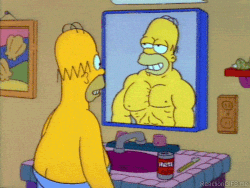
Representation of vigorexia in cartoon.
What are the differences between orthorexia and vigorexia?
Vigorexia is the obsession with achieving an increasingly muscular body, while orthorexia is the obsession with eating healthy and irrational concern about the quality of food. The orthorexic person makes healthy food the main concern of their life and this can affect their daily well-being.
Both are eating disorders. Vigorexia is also usually accompanied by an excessive concern about eating in a certain way, but in orthorexia there is no obsession with gaining muscles.
Are you interested?:
What is hypervigorexia?
The hyper-vigorexic is the person who develops a pathological obsession with achieving superhuman musculature, typical of a heavy bodybuilder or a fictional superhero.
Hypervigorexia is also the tendency to create characters with increasingly surreal muscles that are out of the norm. These characters can be comic book heroes, action toys, movie heroes, anime characters, etc.
According to statistics from a study on college men, 1.9% of them suffered from muscle dysmorphia. Of the people officially diagnosed with this problem, 87.5% are men, aged between 15 and 32 years. This means that those affected are mainly adolescents and young men .
If you think you are suffering from this problem or suspect that someone close to you could be suffering from it, it is important that you read articles like this one. Understand everything about vigorexia and its complications. You can consult sites such as Scielo, Mayo Clinic or Wikipedia. This problem has a cure, but you have to know how to detect it and contact the appropriate professionals.







